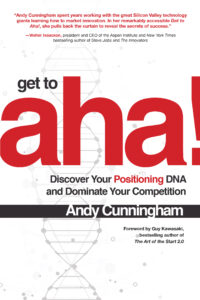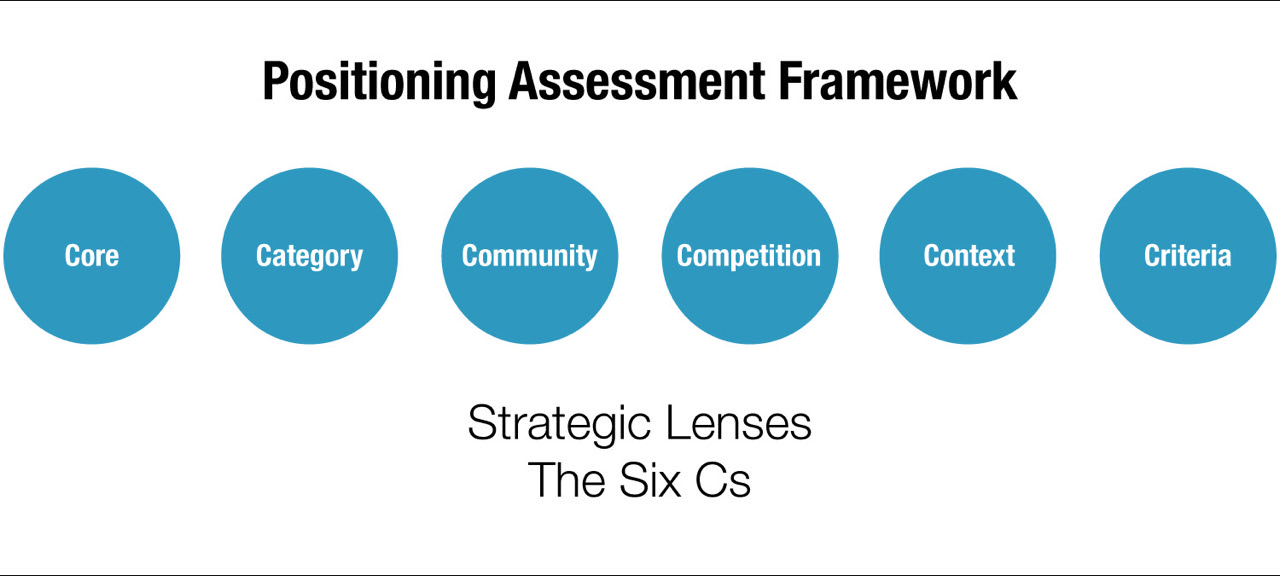Branding that Gets to Aha!
Andy Cunningham played a key role in the launch of the original Macintosh. Which I think qualifies her to say, “Hey, I’m kind of a big deal!” I mean, Steve Jobs level big deal.
But she doesn’t say that at all. Instead, she helps other organizations with branding, positioning and marketing.
She’s just released a book, Get to Aha!: Discover Your Positioning DNA and Dominate Your Competition. It’s a framework to help you understand and position your company. I found it intriguing and asked her to share some of her experience with you.
Branding Gone Wrong
You recently surveyed 100 North American CEOs, and fewer than 1/3 felt that the brand strategy they had commissioned had been effective. Why do we so often get it wrong?
Branding campaigns fail or fall flat for several reasons: resistance to change, uncertainty around how to implement the strategy, too many competing ideas—maybe even business strategy that has moved beyond a recently completed brand initiative.
 But there’s another big reason: branding is too much fun. (Yes, really!) Branding is the part of a marketing campaign that gets a lot of attention—the eye candy that the senior leadership is quick to notice. Why? Because it speaks to the emotional side of a product or service and is a great distraction from the day-to-day, boring details behind that product or service. But when you launch straight into branding before parsing those “boring” details—before you understand the exact space in the marketing landscape your company is uniquely qualified to fill—you’re putting the cart before the horse. A sexy or fun brand package is great to look at, but if it doesn’t capture a company’s role and relevance in the market (its position), then it’s little more than a pretty face without any substance to back it up. That’s where my DNA-based methodology comes in. It offers an actionable framework for using your company’s genetic makeup to determine competitive advantage.
But there’s another big reason: branding is too much fun. (Yes, really!) Branding is the part of a marketing campaign that gets a lot of attention—the eye candy that the senior leadership is quick to notice. Why? Because it speaks to the emotional side of a product or service and is a great distraction from the day-to-day, boring details behind that product or service. But when you launch straight into branding before parsing those “boring” details—before you understand the exact space in the marketing landscape your company is uniquely qualified to fill—you’re putting the cart before the horse. A sexy or fun brand package is great to look at, but if it doesn’t capture a company’s role and relevance in the market (its position), then it’s little more than a pretty face without any substance to back it up. That’s where my DNA-based methodology comes in. It offers an actionable framework for using your company’s genetic makeup to determine competitive advantage.
The 2 Most Important Questions
What questions do you ask to get at the mission or “why” behind a company?
The two most important questions business leaders must answer are: “Who are you as a company?” and “Why do you matter?” Two simple questions; the answers, however, are anything but simple. To get there, you have to understand what—at its core—your company does, what you offer your most important customers, how you are positioned competitively, and how to tell your story in a convincing way. Only when you have these responses at your fingertips will you be in a position to win.
What does great positioning look like?
Pinpointing a company’s precise position in the market acts as a bridge between its business strategy and the face it presents to the outside world. That’s why it’s crucial to get DNA right, since a company’s genetic makeup is the single biggest factor when it comes to identifying its competitive advantage. But what’s also required for great positioning is a clear and concise articulation of a company’s unique role and relevance in the market. It should address the white space in the competitive landscape that can only be filled by the unique superpower possessed by the company in question. A great positioning statement clarifies differentiation and relevance.
Know Your DNA Type
You distinguish companies to help them find their stories. Specifically, you break companies into three DNA types. Mothers (customer-oriented companies). Mechanics (product-oriented companies). Missionaries (concept-oriented companies). How does knowing your DNA type manifest itself into superb marketing?
Only once the management team has a complete and rational understanding of its corporate DNA can it build an emotional narrative that accurately describes who it is and why it matters (e.g., Coca-Cola is carefree, Red Bull is extreme, State Farm is trustworthy). Only then can it move forward and make well-informed and aligned hiring, structuring, compensation, M&A, and—most important—marketing decisions.
In today’s information-everywhere world, authenticity is the currency of reputation and brand building. Knowing what you’re made of enables you to make something of it. It’s what great athletes do. They leverage their DNA to dominate their sport, working with—not against—it. The same is true of companies. Knowing its corporate DNA enables a company to leverage its genetics to be better.
Is it possible to move a company from one DNA type to another?
It isn’t easy and it doesn’t happen often, but you can change your company’s genetic makeup. Amazon, for example, started out as a concept-oriented Missionary, one that forever changed online shopping. Over the years it has morphed into a customer-oriented Mother dedicated to seeing customers get exactly what they want—and quickly.
Just as with personal DNA, altering corporate DNA is complicated; it requires rewiring an organization in nearly every way. That’s why it isn’t a decision to be taken lightly or without a lot of vision and capital (both of which Amazon had in spades). That said, occasional DNA changes do happen on their own as result of an environmental change within the company—a result of maturation or a change in leadership.
In general, however, when it comes to corporate genetics, you are what you are. Companies ignore this reality at their own peril!
Positioning statements. You’ve seen great ones and others that are laughably bad. Would you share one with us and why it works (or doesn’t)?
When it comes to positioning statements, agencies tend to ignore them completely or overlook the all-important “why”—the reason for a company’s existence. Here’s an example of the latter: “We strive to be agile and flexible and give our customers what they want and need.” That’s a commendable goal, but it’s not a positioning statement. Any company in any industry could say the same thing. It doesn’t describe differentiation; it says nothing about a company’s role and relevance in the market, which is the first step in determining competitive advantage and defining your brand. Vague positioning statements stem from a desire to make a company be all things to all people. In the end, however, you end up being nothing to anyone.
In contrast, let’s consider a hypothetical positioning statement for Red Bull. The company’s slogan is, “Red Bull Gives You Wings,” which is all about fun and adventure. If I were tasked with coming up with its positioning statement, however, the focus would not be on fun and adventure. Instead, the statement would read something like, “The energy behind great athletic feats.” That’s it; nothing fancy. Just a rational, practical, factual statement about the company’s singular place in the market. A statement that answers the two key questions: “Who are you?” and “Why do you matter?”
How to Develop a Position Statement
What’s the best process for developing a position statement?
The first step is to look at your company through the lens of what I call the Six Cs. In addition to the four mainstay Cs of marketing—Category, Community, Competition, and Context—my positioning framework introduces two bookend Cs to the mix: Core and Criteria. Core, which is determined via my DNA methodology, serves as the lead dog, and Criteria, a list of five to seven factors you want your positioning statement to accomplish (parameters that let you know you’ve arrived), brings up the rear.

I then apply a formula based on the word game “Mad Libs” to construct a rock-solid positioning statement, one that defines differentiation and relevance. Here’s how it works: “My Company, as an X [DNA type], is focused on X [DNA subtype (what I call a genotype)]. We are an XX company [Category] providing XX [differentiated solution] to XX [target market]. We [value proposition with a verb] by offering [some of the benefits of the product or service]. Our product or service exists because [reason to exist at this time].” (The first sentence, which identifies your DNA and genotype, is just to help you get alignment started. When you take your positioning statement out to market, you’ll leave this part out.)
When you’re done, ask the following questions: Does the statement reflect your DNA? Does it pinpoint the white space you want to own and for whom? Does it differentiate you from your competition? Does it address why you matter? Does it meet at least three-quarters of the criteria you set out for it? If the answer is yes to each question, delete the grounding sentence about your DNA and genotype—that’s for you, not your market—and you’ve got your positioning statement. (An added benefit is that it also offers up your elevator story.)
You were involved with the launch of the original Mac and have seen the marketing landscape change over the years. How has the advent of the web and social media marketing changed how companies position themselves and their services?
The internet changed everything. It exposed the vulnerability of companies to marketing-speak that attempts to build an image without the benefit of underlying substance. When customers and influencers have the level of access to information about products and services that is available today on the web, all bets are off for positioning companies with advertising alone, as was so often the case pre-www. The Marlborough Man created an image for smoking that stuck for decades because it was one-way messaging. The internet is about dialogue. Consequently, positioning must be authentic and credible to be sustainable. Every product and every service is scrutinized by customers and laid bare for the world to see.
For more information, see Get to Aha!: Discover Your Positioning DNA and Dominate Your Competition.

